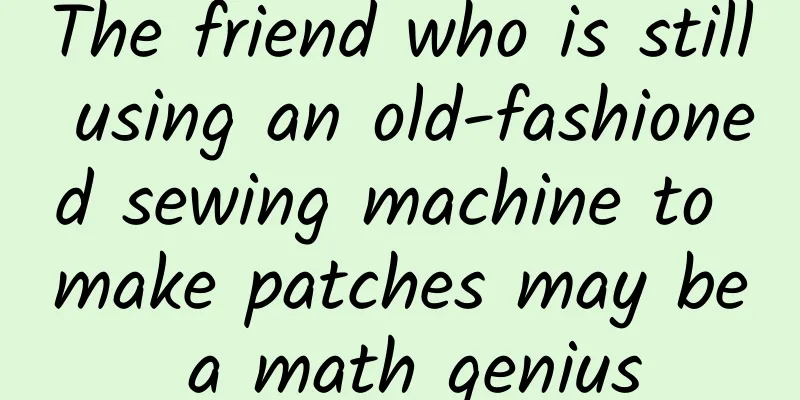The friend who is still using an old-fashioned sewing machine to make patches may be a math genius

|
The old-fashioned pedal sewing machine should be the memory of a generation. Have you ever thought about its principle? In order to use it more conveniently, smart engineers have been constantly innovating this machine for hundreds of years. There is a lot of wonderful mathematics here. Even though smart electric sewing machines have appeared today, the sewing method for processing fabrics is still various combinations of threads. Looking at these old objects again may give people new inspiration. By Tony Philips (Professor Emeritus of Mathematics, Stony Brook University) Compiled by Hadron The sewing machine is one of the mechanical wonders of the 19th century. Mahatma Gandhi is said to have called it "one of the few useful inventions of mankind". This automated tool, unlike a printer or a money counter, processes actual materials rather than presenting information. In this article I will explore the mathematical principles of the sewing machine and the bobbin winder, which are often mentioned together: how the double-thread lockstich (also known as the lockstitch, the most common process on sewing machines) is realized at the topological level, and how the cam in the shape of an Archimedean spiral ensures that the thread is evenly wound on the long bobbin. Line step topology The most primitive sewing machines used a single-thread chain stitch: Chain stitch sewing method: With each stitch, a circle of silk thread is pulled into the loop formed by the previous circle of thread. Chain stitching is not a topological problem because the thread does not tangle at all - just pulling the right end of the thread in the picture above is enough to make the entire seam fall apart. This is useful for some situations where it is easy to open, such as a bag full of potatoes or dog food at home. However, sometimes this feature is disastrous, unless you really want a piece of clothing that will fall apart if you pull it. The earliest sewing machines that could achieve the lockstitch method were invented between 1830 and 1850. This sewing machine used two strands of thread to sew. Lockstitch method: At each stitch, the upper thread is twisted together with the lower thread and in the same direction. If you ignore the fabric to be sewn, you will see that the two threads are evenly twisted together, one around the other. At first glance, it seems topologically impossible to sew a lockstitch by machine. Sewing machines use two threads to create a seam, and each thread comes from a spool - the upper thread comes from a spool located on the top of the machine, and the lower thread comes from a bobbin hidden in the shuttle inside the sewing machine. So the question is, how do the two threads get entangled in a circle? The answer is simple: the bobbin is not fixed to the sewing machine. On early sewing machines, the bobbin was mounted in a bullet-shaped shuttle. With each stitch, the shuttle advanced through the upper thread, and when the needle was raised, the shuttle retreated, completing a complete circle. The shuttle's ability to move freely through the sewing machine is key to this type of stitching. In more modern sewing machines, the bobbin is stuck in a smooth, round metal shuttle that is in a fixed position, but is not completely fixed, and can rotate. With each stitch, the upper thread is hooked onto the metal shuttle, which rotates to entangle the lower thread and tighten it. Figure a Figure b Two solutions for achieving a lock stitch. Figure a: "Oscillating shuttle". With each stitch, the shuttle carries the bobbin (blue thread) through the loop formed by the upper thread (red). Figure b: "Rotating shuttle". The bobbin (green thread) is enclosed in a round, smooth shuttle that remains stationary, and with each stitch the upper thread (yellow) is pulled around the shuttle. In both cases, the shuttle must be able to move freely within the machine in order to be topologically possible. The magical Archimedean spiral I learned about these interesting things from my former colleague and friend Enrico Giusti (Italian mathematician). He mentioned sewing machines and bobbin winders in a lecture at the "Matematica e Cultura" conference in Venice. They can also be found in the "Garden of Archimedes", the mathematics museum in Florence. Another Italian mathematician, Franco Conti, created this exhibition based on the book Oltre il Compasso: la geometria delle curve ("Beyond the Compass: The Geometry of the Curve") published by him and Giusti in 2000. The working mechanism of these bobbin winders is also available on the museum website. For those who are not familiar with the chain stitch machine, each machine is different because they have their own unique bobbin - a small spool that fits inside the shuttle and holds the thread underneath. To make it easier to wind the thread onto the spool inside the bobbin, each sewing machine has a device called a bobbin winder, which is usually located next to the sewing machine's main shaft, away from the sewing action. The picture on the left shows a classic sewing machine, the Singer Sphinx Model 27, manufactured in 1910. The picture on the right shows a close-up of the bobbin winder. The Model 27 was designed with an oscillating shuttle. Bullet-shaped oscillating shuttle model and bobbin, the one shown is about 1.5 inches long. For shorter bobbins like those in a rotary shuttle, getting the thread to wind evenly is usually not a problem, as the bobbin winder on the sewing machine allows the thread to be drawn out evenly (of course, it is recommended that you keep an eye on the winding process and adjust it by hand if necessary). But it is not so easy with narrow and long bobbins like the one used in the older models in the picture above: the thread needs to be guided back and forth along the bobbin during winding. A very simple solution is to design a movable structure on the bobbin winder to achieve the back and forth movement. The picture below shows this simple mechanism, where the thread can be guided through a rotating ring with a diameter equal to the length of the bobbin and then connected to the bobbin winder at a fixed point, but this will cause the thread to pile up at the ends of the bobbin. In the picture on the right, you can see that the green area has twice as much thread wound as the red area of the same length. Conti explains why this causes the thread to pile up at the ends of the bobbin. Figure (a) is a schematic diagram of the actual device. The bobbin rotates at a constant speed parallel to the paper surface, and the disk rotates at a constant speed perpendicular to the paper surface. The position of the bobbin corresponding to the black dot on the disk is the winding position. The length of time the black dot stays above the bobbin determines the amount of winding. As shown in Figure (b), when the disk rotates uniformly for one circle, the central angle of the green part of the bobbin on the disk is twice the central angle of the red part, so the winding amount of the green area is twice that of the red area. It can be seen that the winding will be stacked at both ends of the bobbin, and the result is shown in Figure (c). The solution proposed by the inventors and subsequent developers of this type of sewing machine is to install a heart-shaped cam on a rotating disk similar to the one in the figure above, like two Archimedean screws put together. (In polar coordinates, this can be expressed as r=θ when 0≤θ≤π, and r=−θ when −π≤θ≤0). The arm connected to it can be adjusted to match the length of the winder. This device that uses the Archimedean screw to convert circular motion into uniform linear motion is included in 507 Mechanical Movements, published in 1868. (507 Mechanical Movements, author Henry T. Brown is the editor of The American Artisan magazine. This publication specializes in publishing new content in the field of mechanical engineering during the Industrial Revolution. Brown eventually compiled it into a book and published it in 21 editions. The book can now be found online and has animated images.) This ingenious device on the sewing machine is the 96th one, and the book also gives an explanation. Archimedean spiral Heart-shaped cam recorded in the book of 507 mechanical movements Heart-shaped cam. The rotation of the heart-shaped cam can make the arm move evenly horizontally. The dotted line fits the motion trajectory of the heart-shaped cam. The arm device is divided into arbitrary parts, and a series of concentric circles are determined from these points. Starting from the leftmost point of the outer circle, every time you move a small grid towards the center, you need to rotate at an evenly spaced angle and gradually move towards the center. Then, the intersection of these concentric circles and the outward radiating lines is the curve we hope to fit. The popular CDs in the early years were actually made of a strip of information-carrying medium (1.6 microns thick), which was also an Archimedean spiral. The advantage of this is that when the CD rotates at a constant speed, the laser head that reads the information only needs to move radially along the CD at a constant speed to read the information recorded on the strip of information evenly and without interruption. The older phonograph vinyl records also work on a similar principle, and the information carrier on its surface - the grooves - form a perfect Archimedean spiral. The Archimedean spiral is a trajectory formed by both uniform rotation and uniform linear motion. The difference is that some are uniform linear motions perpendicular to the rotating axis, such as the cam and disc mentioned above; some are uniform linear motions parallel to the rotating axis, such as the Archimedean water pump. It is said that in the 3rd century BC, Archimedes invented a cylindrical spiral water pump to solve the problem of irrigating the land with water from the Nile River. Later generations called it the "Archimedean spiral". The Archimedean spiral water pump is the oldest water pump. It uses the spiral surface to rotate around the rotating axis to transfer water from a low place to a high place for farmland irrigation. With its advantages such as simple operation, easy structure and maintenance, and stable flow rate, Archimedean screw pumps are still used in industrial applications. The picture above shows an Archimedean screw water pump. Every time the shaft rotates one circle, the water in each grid is pushed forward one pitch. It should be noted that the Archimedean spiral is often confused with another common spiral, the equiangular spiral (or logarithmic spiral). The difference between them is that the latter rotates in a geometric exponential increment, while the Archimedean spiral is constant. The great mathematician Jacob Bernoulli was obsessed with this curve. It is said that he asked for an equiangular spiral to be engraved on his tombstone after his death. As a result, the craftsman finally engraved the Archimedean spiral. Equiangular spiral Archimedean spiral, this simple and profound curve also appears in various engineering applications today, from small screws to large communication antennas. The charm of technology lies in the practical applications it brings to mankind, and the principles behind it show the magic of nature. Perhaps you can find scientific principles that you have not noticed in the past when you dig out the sewing machine that is still in the corner of the storage room. The pictures in this article are all from the Internet. |
<<: How to choose between live fish, fresh fish and frozen fish? Just read this article!
>>: Can “sleep-aiding foods” really improve sleep?
Recommend
Why did quantum dots, which can solve the weakness of LCD picture quality, wait until this year to appear?
A new term for LCD TVs has entered the vision of ...
The "little apple" from 400 million years ago was fixed to the seabed like an anchor!
From the middle Ordovician to the late Devonian, ...
How to plan a hot-selling content promotion that will sweep the screen?
Most content operators expect explosive content ,...
How much does it cost to develop a Lianyungang real estate mini program? Lianyungang real estate applet development price inquiry
There are two types of Lianyungang real estate We...
How to make money by placing ads on your website?
There are more and more new webmasters nowadays. ...
Android N debuts at Google I/O, name still undecided
In the early morning of May 19th, the annual Goog...
Aspartame is harmful to cardiovascular system, so we can no longer drink sugar-free beverages?
Studies have found that aspartame can damage the ...
4 key points for brand event promotion!
To effectively promote a brand event , you need t...
HEYTEA launches new brand strategy
Heytea has reduced its prices again! When hearing...
Geely withdraws from CHS, subsidies are stopped, will China's hybrid cars be in decline?
Recently, Guangzhou issued the latest revised &qu...
What does security assessment of IDC computer room mean?
Level protection assessment is an activity carrie...
APP Packaging Party’s Business Secrets
Low threshold, zero cost and high income have led...
Top 10 tips for keeping your private photos safe
Once upon a time, there was a man who could not r...
How to build an Android MVVM application
1. Overview Databinding is a framework, MVVM is a...
Why I don't buy an Apple Watch
[[128371]] Since the release of Apple Watch, it s...









